Table of Contents[Hide][Show]
- Nutrivore Score for Ground Beef, 85%/15% – 197
- Ground Beef, 85%/15% Nutrition Facts
- Ground Beef Nutrition Varies With Fat Content
- Ground Beef, 85%/15% Nutrition Varies With Cooking
- Beef Nutrition Varies With Processing
- Ground Meat Nutrition Varies With Type
Health Benefits of Ground Beef Nutrients+−
- Ground Beef, 85%/15% Provides 90% DV Vitamin B12 (Cobalamin)
- Ground Beef, 85%/15% Provides 3.0 mg of CoQ10
- Ground Beef, 85%/15% Provides 41% DV Zinc
- Ground Beef, 85%/15% Provides 18.6 g of Protein
- Ground Beef, 85%/15% Provides 32% DV Monounsaturated Fatty Acids (MUFA)
- Ground Beef, 85%/15% Provides 29% DV Selenium
- Ground Beef, 85%/15% Provides 29% DV Vitamin B3 (Niacin)
- Ground Beef, 85%/15% Provides 100.0 mg of Taurine
- Ground Beef, 85%/15% Provides 20% DV Vitamin B6 (Pyridoxine)
- How Much Ground Beef Should We Eat Per Day?
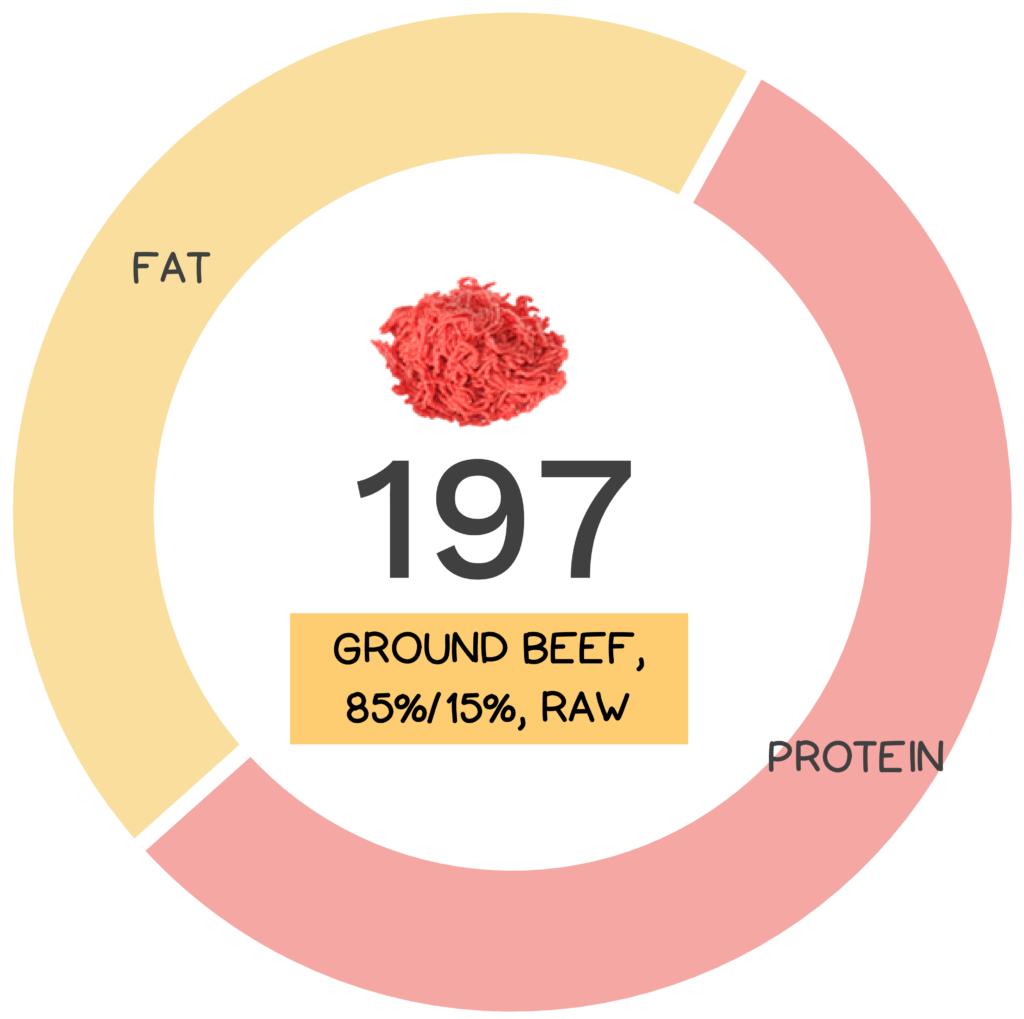
When it comes to meat, beef is arguably one of the most popular choices in cuisines across the globe. In fact, beef is the third most widely consumed meat in the world, after pork and chicken, with over 940 million cattle worldwide. Whether you prefer this red meat BBQ’d, braised, broiled, cured, grilled, roasted, or stewed; well-done, medium, rare or even raw (steak tartare I’m looking at you!), figuring out the best way to include this food in your diet is something definitely worth “ruminating” over.
Beef refers to meat from cows, while veal is the meat from calves (young cows).
The term beef refers to meat from cows, while veal is the meat from calves (young cows). Consumption of beef traces back to prehistoric times, when early humans hunted aurochs, the ancestor of modern cattle – a scene portrayed in some of the earliest known cave paintings. Amazingly, all the cattle we have today descended from as little as 80 original animals domesticated between 7,000 and 10,500 years ago. These cattle were domesticated for their leather, meat, and milk. Over time various breeds of cattle have been bred for the quality and quantity of their meat. Some famous examples of widely recognized beef include Angus beef, which comes from the Aberdeen Angus cow breed, known for its marbling and juicy flavor; Wagyu, which is one of four Japanese beef cattle breeds famous for their texture and flavor; and Kobe beef which is a specific type of Wagyu beef with a set of very strict and precise standards it must comply with in order to qualify for this prestigious title. (Holy cow!)
In some countries the killing and consumption of cows is prohibited for religious reasons.
Once you’ve selected your breed of choice, there are still so many options to choose from with respect to this popular meat. Grass-fed refers to animals consuming grass and foraging for most or all of their lives, while grain-fed cattle are finished on a grain-based diet usually consisting of corn and soy. There are also numerous cuts of beef you can choose from – popular ones include different types of brisket, steak, roast, ribs, sausage, hamburger, and the widely popular and versatile ground beef. When it comes to this food, the possibilities are endless!
Although beef is popular it is not widely consumed in all countries. In fact, most of the states in India and the country of Nepal prohibit killing and consumption of cows for religious reasons. On the other hand, the largest producers (and consumers) of beef include United States, Brazil, and China, with the average American devouring roughly 27 kg (59 lbs) of beef per year, as of 2021! I guess all that’s left to say is “Where’s the beef?”
Nutrivore Score for Ground Beef, 85%/15% – 197
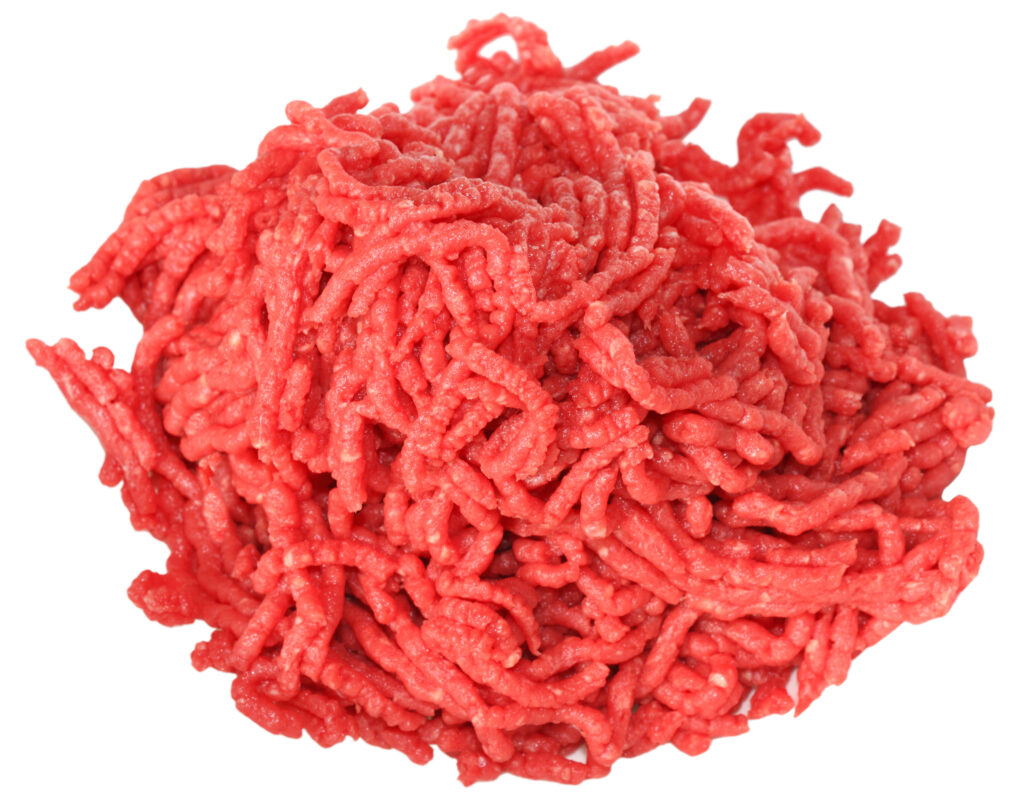
Ground beef, 85%/15% has a Nutrivore Score of 197, making it a medium nutrient-dense food! Plus, it is a low-carb food; ground beef, 85%/15% has 0 grams of net carbs per 3.5-ounce serving.
Per serving, ground beef, 85%/15% is a best source (>50% daily value) of coQ10 and vitamin B12 (cobalamin); an excellent source (20-50% daily value) of monounsaturated fatty acids (MUFA), protein, selenium, taurine, vitamin B3 (niacin), vitamin B6 (pyridoxine), and zinc; and a good source (10-20% daily value) of choline, conjugated linoleic acids (CLA), iron, phosphorus, vitamin B2 (riboflavin), and vitamin B5 (pantothenic acid).
Ditch Diets. Embrace Nutrients. Start with this FREE Guide.
Sign up for the free Nutrivore Newsletter, your weekly, science-backed guide to improving health through nutrient-rich foods — without dieting harder —and get the Beginner’s Guide to Nutrivore delivered straight to your inbox!

Ground Beef, 85%/15% Nutrition Facts
One serving of ground beef, 85%/15% is standardized to 100 grams (3.5 ounces). When you cook ground beef, 85%/15%, it reduces in volume by approximately 15%: 100 grams of raw ground beef, 85%/15% is equivalent to 84 grams of cooked ground beef, 85%/15%.
Ground Beef, 85%/15% Nutrition Facts Per Serving
| Ground beef, 85%/15%, raw | Nutrivore Score: 197 | Nutrient Density: Medium |
|---|---|---|
| Serving Size: 3.5 ounces (100 grams) | Protein: 18.6 grams | Net Carbohydrates: 0.0 grams |
| Calories: 215 | Total Fat: 15.0 grams | Dietary Fiber: 0.0 grams |

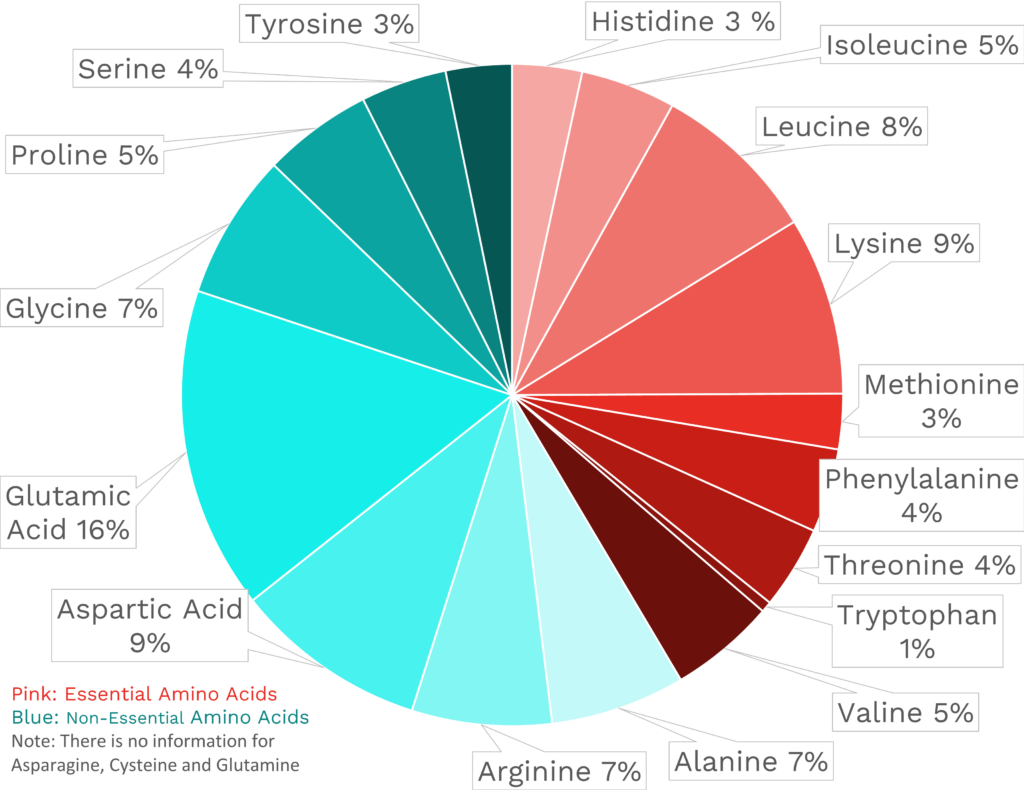
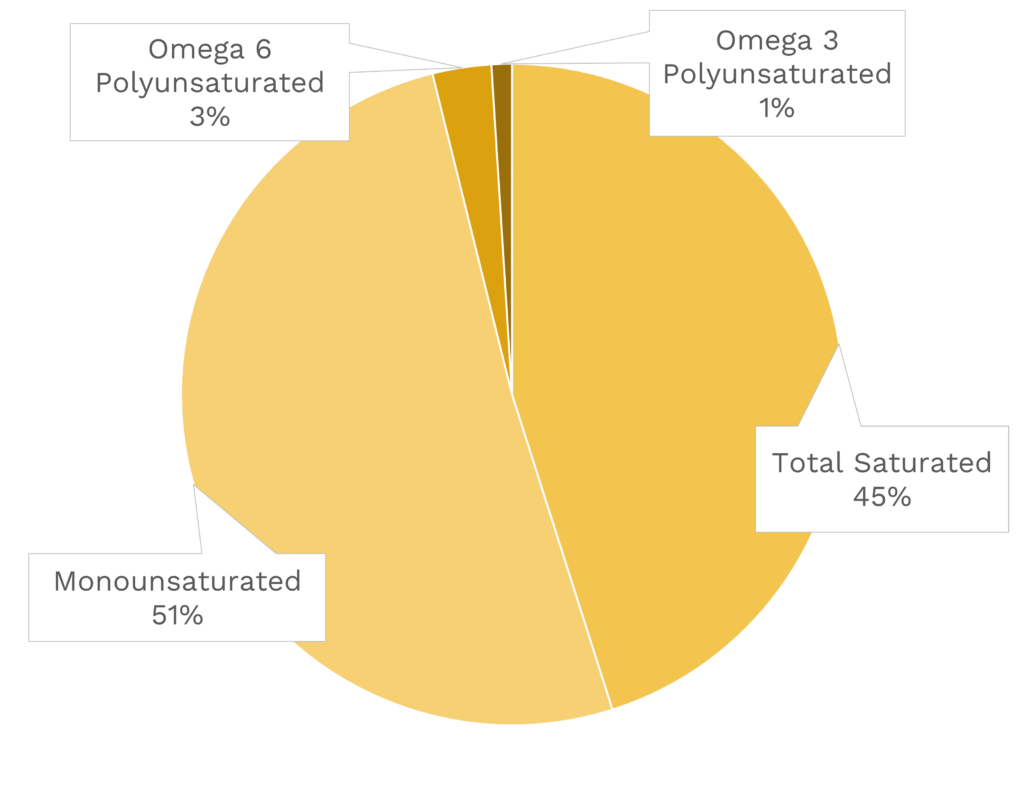
| VITAMINS | ||
|---|---|---|
| Vitamin A | 4.0 μg RAE | 0% DV |
| Vitamin B1 (Thiamin) | 42.0 μg | 4% DV |
| Vitamin B2 (Riboflavin) | 151.0 μg | 12% DV |
| Vitamin B3 (Niacin) | 4.6 mg | 29% DV |
| Vitamin B5 (Pantothenic Acid) | 0.5 mg | 11% DV |
| Vitamin B6 (Pyridoxine) | 346.0 μg | 20% DV |
| Vitamin B7 (Biotin) | 0.6 μg | 2% DV |
| Vitamin B9 (Folate) | 6.0 μg | 2% DV |
| Vitamin B12 (Cobalamin) | 2.2 μg | 90% DV |
| Vitamin C | 0.0 mg | 0% DV |
| Vitamin D (D2 + D3) | 0.1 μg | 1% DV |
| Vitamin E | 0.2 mg | 1% DV |
| Vitamin K | 1.3 μg | 1% DV |
| Choline | 61.2 mg | 11% DV |
| Myo-Inositol | 30.0 mg | ~ |
| CoQ10 | 3.0 mg | ~ |
| FUNCTIONAL FATS | ||
|---|---|---|
| MUFA | 6.5 g | 32% DV |
| ALA | 54.0 mg | 3% DV |
| EPA + DHA | 3.0 mg | 1% DV |
| CLA | 113.4 mg | ~ |
| Linoleic Acid | 0.3 g | 2% DV |
| MCT’s | 0.0 g | ~ |
| MINERALS | ||
|---|---|---|
| Calcium | 15.0 mg | 1% DV |
| Copper | 67.0 μg | 7% DV |
| Iodine | ~ | ~ |
| Iron | 2.1 mg | 12% DV |
| Magnesium | 18.0 mg | 4% DV |
| Manganese | 10.0 μg | 0% DV |
| Phosphorus | 171.0 mg | 14% DV |
| Potassium | 295.0 mg | 6% DV |
| Selenium | 15.8 μg | 29% DV |
| Sodium | ~ | ~ |
| Zinc | 4.5 mg | 41% DV |
| PHYTONUTRIENTS | ||
|---|---|---|
| Carotenoids | 0.0 μg | ~ |
| Polyphenols | 0.0 mg | ~ |
| Phytosterols | 0.0 mg | ~ |
| Glucosinolates | ~ | ~ |
| Thiosulfinates | ~ | ~ |
| Betalains | ~ | ~ |
| AMINO ACIDS & PEPTIDES | ||
|---|---|---|
| Taurine | 100.0 mg | ~ |
| Ergothioneine | 0.1 mg | ~ |
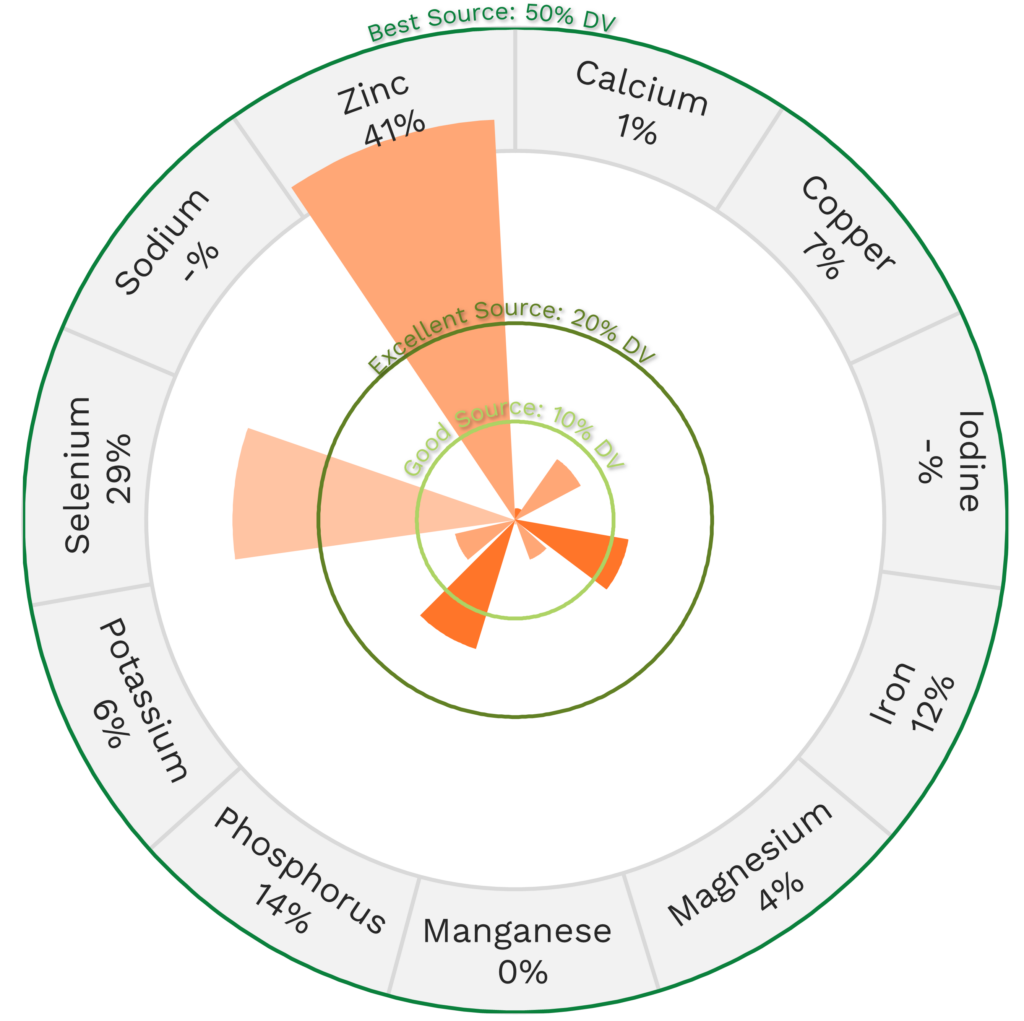
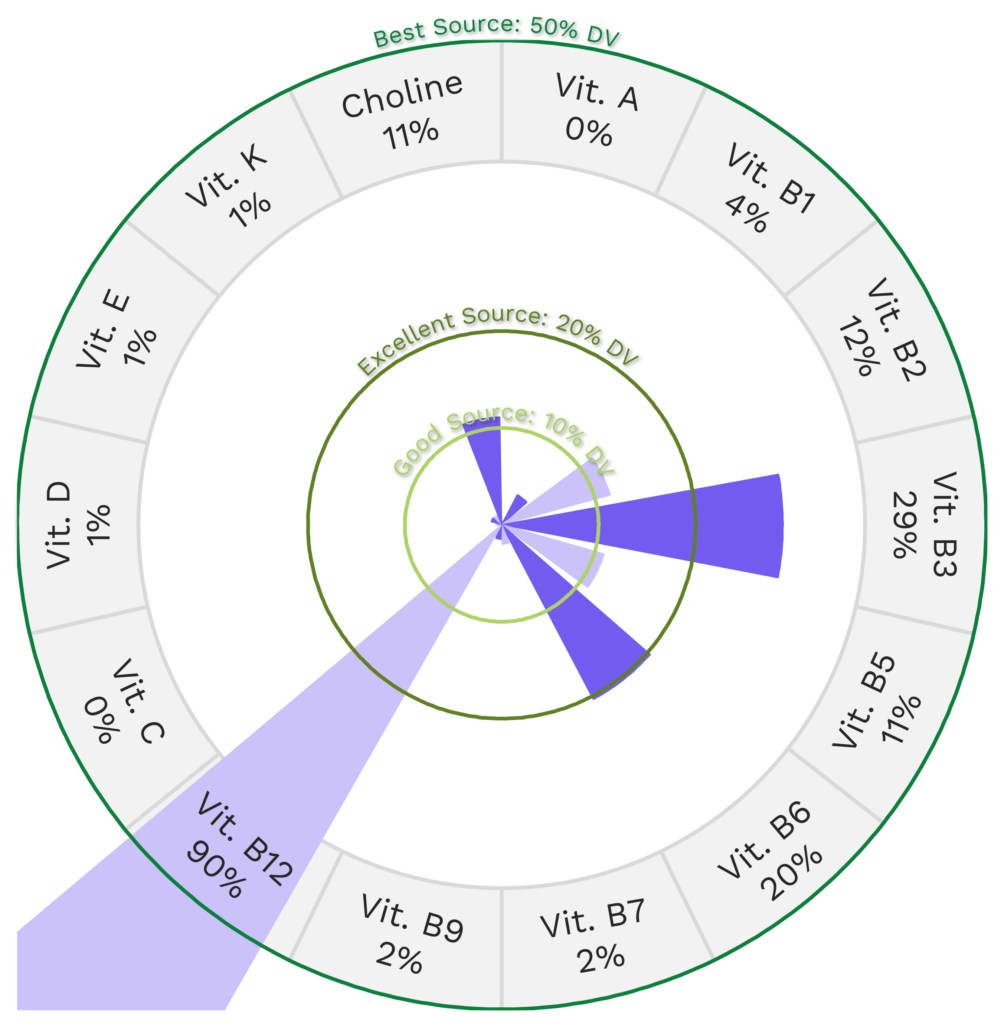
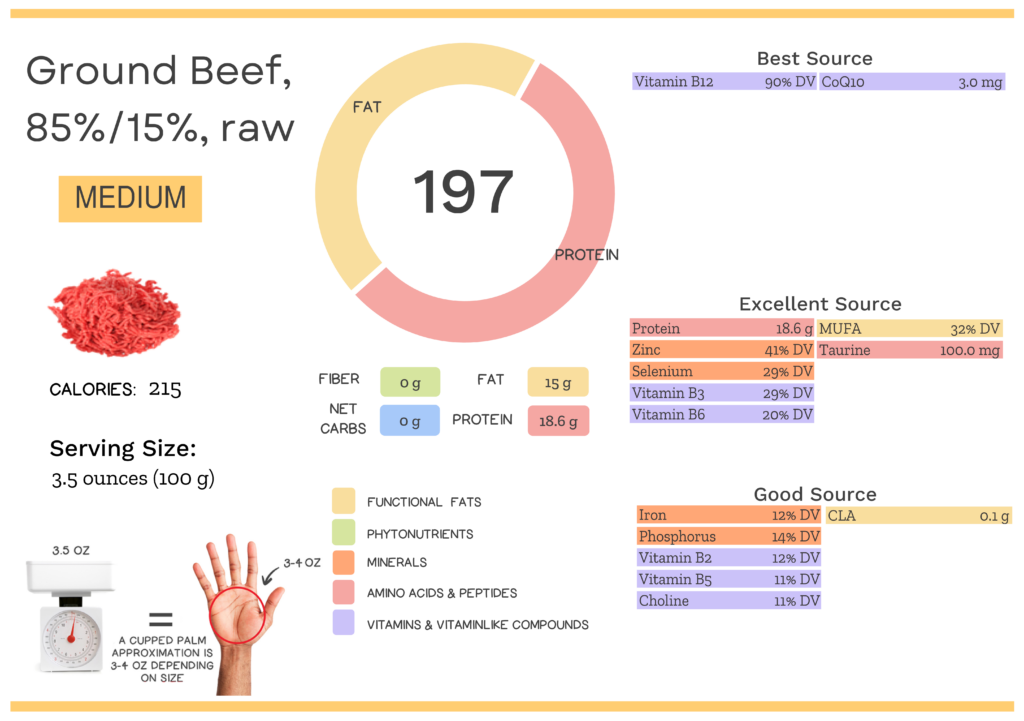

Quality Meat and Seafood
- 100% grass-fed and finished beef, bison and lamb
- 100% pasture-raised pork, chicken, duck and turkey
- Wild-caught seafood
- Raised on regenerative family farms
- Fast delivery from our farms to your door
Ground Beef Nutrition Varies With Fat Content
Ground beef, with varying fat content, is available for purchase from most grocery stores. Sometimes these are labelled as extra lean, lean, medium, or regular but the requirements for these labels vary from country to country. For instance, in Canada extra lean has a maximum fat content of 10%, lean – 17%, medium – 23%, and regular – 30%. However, in the United States, extra lean has a maximum fat content of 5%, while lean has a maximum of 10%. When in doubt, check the label, which should specify the amount of fat in that particular product. Although some types of ground beef will work better in certain recipes, for the most part they are fairly interchangeable and the type you choose comes down to personal preference. Keep in mind that the Nutrivore Scores for ground beef will vary based on fat content since those that contain more fat are higher in calories.
| NUTRIVORE SCORE | |
|---|---|
| Ground beef, 70% lean meat / 30% fat, raw | 125 |
| Ground beef, 75% lean meat / 25% fat, raw | 142 |
| Ground beef, 80% lean meat / 20% fat, raw | 165 |
| Ground beef, 85% lean meat / 15% fat, raw | 197 |
| Ground beef, 90% lean meat / 10% fat, raw | 244 |
| Ground beef, 93% lean meat / 7% fat, raw | 284 |
| Ground beef, 95% lean meat / 5% fat, raw | 316 |
| Ground beef, 97% lean meat / 3% fat, raw | 360 |
Ground Beef, 85%/15% Nutrition Varies With Cooking
Ground beef is a popular ingredient in the kitchen and accounts for the majority of fresh beef purchased in many countries. This meat is extremely versatile and can be prepared in numerous ways, resulting in different flavors, textures, and Nutrivore Scores.
| NUTRIVORE SCORE | |
|---|---|
| Ground beef, 85%/15%, crumbles, cooked, pan-browned | 216 |
| Ground beef, 85%/15%, loaf, cooked, baked | 207 |
| Ground beef, 85%/15%, patty, cooked, broiled | 208 |
| Ground beef, 85%/15%, patty, cooked, pan-broiled | 221 |
| Ground beef, 85%/15%, raw | 197 |
Beef Nutrition Varies With Processing
The Nutrivore Score of beef differs based on processing. Within any animal, vitamin and mineral content vary, which means nutrient density varies between cuts of meat. Butchering therefore has a huge impact on the Nutrivore Score of different cuts of beef, of which there are many! Especially significant is the difference between organ meat and ‘muscle’ meat. Not only does the portion of the animal being consumed affect the nutrient profile, but also important is the fat content.
| NUTRIVORE SCORE | |
|---|---|
| Beef, bottom sirloin, tri-tip roast, separable lean and fat, 0″ fat, all grades, raw | 250 |
| Beef, brisket, whole, separable lean only, all grades, raw | 287 |
| Beef, chuck, blade roast, separable lean and fat, 1/8″ fat, all grades, raw | 204 |
| Beef, chuck eye roast, boneless, separable lean and fat, 0″ fat, all grades, raw | 280 |
| Beef, chuck for stew, separable lean and fat, all grades, raw | 379 |
| Beef, chuck, short ribs, boneless, separable lean and fat, 0″ fat, all grades, raw | 218 |
| Beef, composite of trimmed retail cuts, separable lean and fat, 1/8″ fat, all grades, raw | 204 |
| Beef, flank, steak, separable lean and fat, 0″ fat, all grades, raw | 277 |
| Beef, ground, 85%/15%, raw | 197 |
| Beef, heart, raw | 888 |
| Beef, kidney, raw | 2543 |
| Beef, liver, raw | 4021 |
| Beef, loin, tenderloin roast, boneless, separable lean and fat, 0″ fat, all grades, raw | 344 |
| Beef, loin, tenderloin steak, boneless, separable lean and fat, 0″ fat, all grades, raw | 348 |
| Beef, loin, top loin, separable lean and fat, 1/8″ fat, choice, raw | 201 |
| Beef, rib, back ribs, bone-in, separable lean and fat, 0″ fat, all grades, raw | 1311 |
| Beef, rib, small end (ribs 10-12), separable lean and fat, 1/8″ fat, all grades, raw | 174 |
| Beef, rib, large end (ribs 6-9), separable lean and fat, 1/8″ fat, all grades, raw | 154 |
| Beef, rib, shortribs, separable lean and fat, choice, raw | 126 |
| Beef, rib, whole (ribs 6-12), separable lean and fat, 1/8″ fat, all grades, raw | 1581 |
| Beef, ribeye cap steak, boneless, separable lean only, 0″ fat, all grades, raw | 2871 |
| Beef, round, eye of round roast, boneless, separable lean only, 0″ fat, all grades, raw | 357 |
| Beef, round, knuckle, tip center, steak, separable lean and fat, 0″ fat, all grades, raw | 403 |
| Beef, round, tip round, separable lean and fat, 1/8″ fat, all grades, raw | 2521 |
| Beef, round, top round roast, boneless, separable lean only, trimmed to 0″ fat, all grades, raw | 357 |
| Beef, short loin, porterhouse steak, separable lean and fat, 1/8″ fat, all grades, raw | 206 |
| Beef, short loin, t-bone steak, separable lean and fat, 1/8″ fat, all grades, raw | 193 |
| Beef, shoulder pot roast or steak, boneless, separable lean and fat, 0″ fat, all grades, raw | 407 |
| Beef, striploin, New Zealand, grass-fed, separable lean only, raw | 209 |
| Beef, tenderloin, steak, separable lean and fat, 1/8″ fat, all grades, raw | 182 |
| Beef, top sirloin, steak, separable lean and fat, 1/8″ fat, all grades, raw | 217 |
| Beef, tongue, raw | 215 |
Ground Meat Nutrition Varies With Type
There are many different types of ground meat which can be used in place of, or in addition to, ground beef. These will vary in color, taste, texture, and Nutrivore Score.
| NUTRIVORE SCORE | |
|---|---|
| Beef, grass-fed, ground, raw | 208 |
| Beef, ground, 85%/15%, raw | 197 |
| Bison, ground, raw | 208 |
| Chicken, ground, raw | 282 |
| Deer, ground, raw | 437 |
| Elk, ground, raw | 3761 |
| Emu, ground, raw | 568 |
| Lamb, ground, raw | 186 |
| Ostrich, ground, raw | 357 |
| Pork, ground, 84%/16%, raw | 213 |
| Turkey, ground, raw | 295 |
| Veal, ground, raw | 230 |
Did you find all this nutrition “ground” breaking? Maybe your friends will too!
Health Benefits of Ground Beef Nutrients
Let’s take a closer look at all of the best and excellent source of nutrients found in a 3.5-ounce serving of ground beef, 85%/15% and see how they benefit our health.
Ground Beef, 85%/15% Provides 90% DV Vitamin B12 (Cobalamin)
Ground beef, 85%/15% is a best source of vitamin B12 (cobalamin), providing 90% of the daily value per 3.5-ounce serving!

Vitamin B12 (cobalamin) is a water-soluble vitamin that serves as a cofactor for enzymes involved in energy metabolism, red blood cell production, DNA synthesis, neurotransmitter production, nervous system health, and folate metabolism. As a result of these roles, vitamin B12 is vital for maintaining brain and nervous system health, and may have a protective effect against dementia, Alzheimer’s disease, and depression. There’s also some evidence vitamin B12 may be cancer-protective, possibly through supporting folate metabolism (which then assists in repairing DNA damage). Learn more about vitamin B12 here.
Ground Beef, 85%/15% Provides 3.0 mg of CoQ10
Ground beef, 85%/15% is also a best source of coQ10, providing 3.0 mg of coQ10 per 3.5-ounce serving!
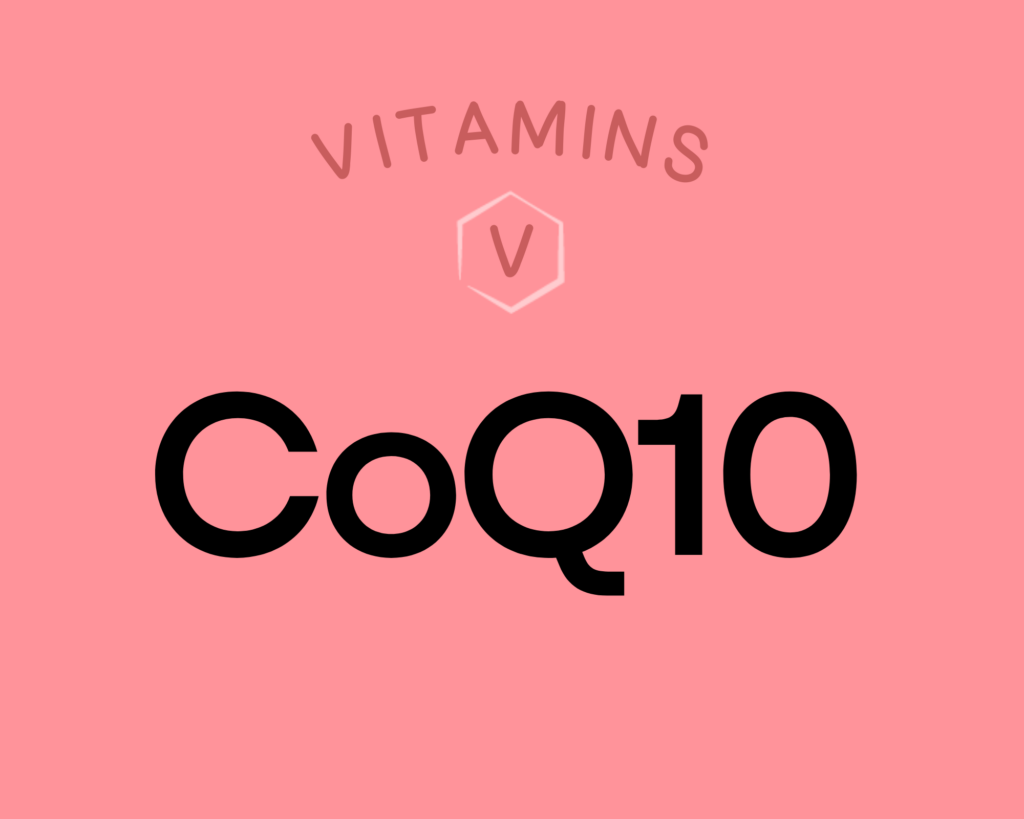
Ubiquinone is the oxidized form and ubiquinol is the reduced, more bioavailable form of the vitaminlike compound coenzyme Q10 (coQ10). CoQ10 is a potent antioxidant and a cofactor in the electron transport chain for the production of ATP. It may be helpful in treating or preventing heart and blood vessel conditions, diabetes, gum disease, muscular dystrophy, chronic fatigue syndrome, and breast cancer. Sources include beef, pork, mackerel, yellowtail fish, and chicken; it’s also found in smaller amounts in vegetables like broccoli and herbs like parsley. Learn more about coQ10 here.
Ground Beef, 85%/15% Provides 41% DV Zinc
Ground beef, 85%/15% is an excellent source of zinc, providing 41% of the daily value per 3.5-ounce serving!

Zinc is an essential trace mineral that serves as a cofactor for over 300 enzymes and 1000 transcription factors, giving it important roles in immune function, sensory organ function, reproduction, gene regulation, DNA synthesis, wound healing, and the metabolism and activity of multiple other nutrients. Research shows it can reduce the duration of the common cold when taken shortly after the onset of illness, and can also benefit immune health in the elderly and among HIV/AIDS patients. Some studies also suggest a protective role of zinc in neurological conditions like Alzheimer’s disease and depression. Learn more about zinc here.
Ground Beef, 85%/15% Provides 18.6 g of Protein
Ground beef, 85%/15% is also an excellent source of protein, providing 18.6 g of protein per 3.5-ounce serving!
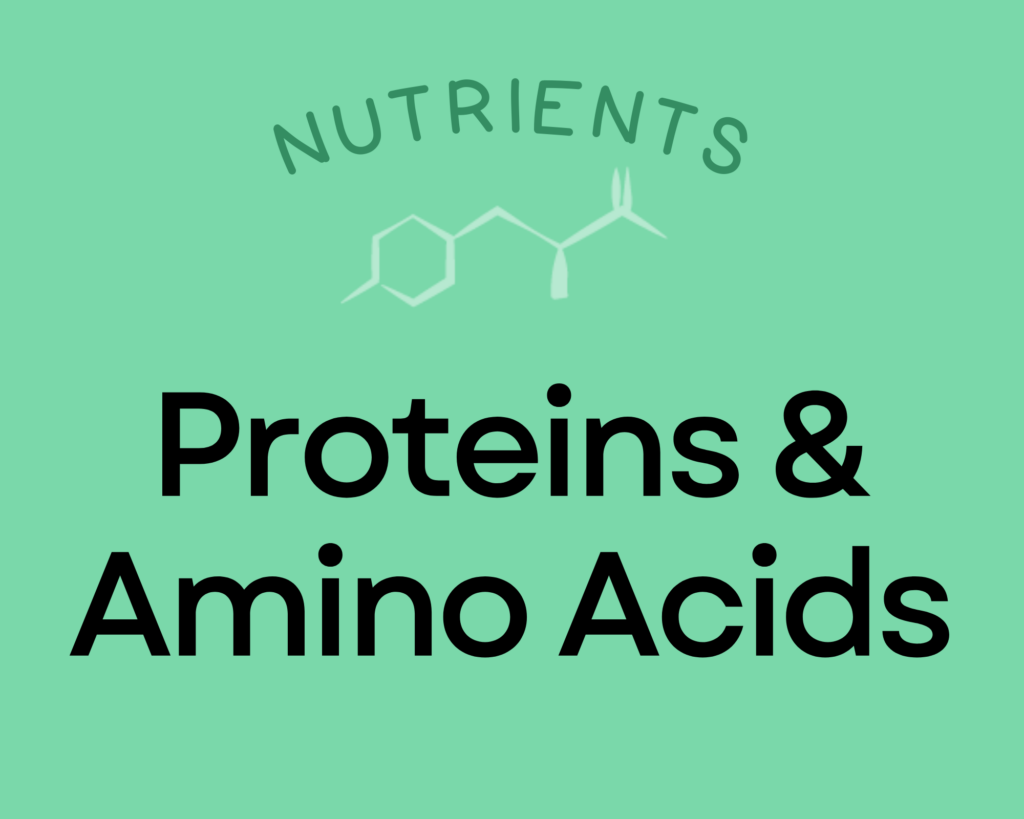
Proteins are the molecules that actually perform most of the various functions of life. In addition to being major structural components of cells and tissues, they have incredibly diverse roles from driving chemical reactions (e.g., enzymes) to signaling (e.g., some types of hormones) to transporting and storing nutrients. Dietary protein is necessary to supply the amino acid building blocks for all of the proteins in our bodies. The recommended daily allowance of protein is 0.36 grams per pound body weight (0.8 grams per kilogram of body weight). That amounts to 56 grams for a 150-pound person. However, it’s important to emphasize that this number is considered a minimum daily allotment, and there is no established upper limit. In fact, many studies have evaluated diets containing three to four times more protein than this minimum and proven benefits to weight management, body composition, hormone regulation, and cardiovascular health. These studies suggest that an optimal protein intake for most people is probably in the range of 1.2 to 1.8 grams per kilogram bodyweight (82 to 122 grams for that same 150-pound person), and that people who are very active may see the best results at even higher intake. Learn more about protein and amino acids here.
Ground Beef, 85%/15% Provides 32% DV Monounsaturated Fatty Acids (MUFA)
Ground beef, 85%/15% is an excellent source of monounsaturated fatty acids (MUFA), providing 32% of the daily value per 3.5-ounce serving!
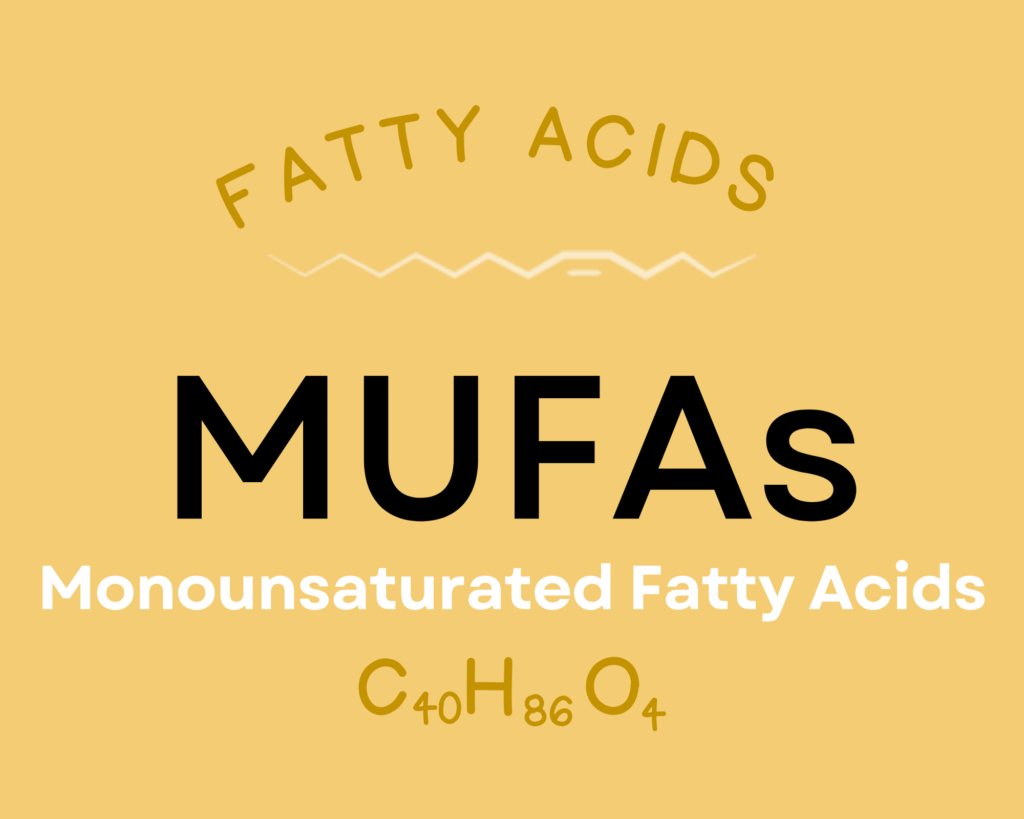
Monounsaturated fatty acids (MUFA), the most abundant of which is oleic acid, play an important role in cellular function due to its presence in phospholipids in cell membranes. Oleic acid is beneficial for cardiovascular health—both in reducing risk factors like high blood pressure, cholesterol, triglycerides, inflammation, and oxidative stress, and in reducing actual cardiovascular disease incidence and events. Oleic acid has even demonstrated anti-cancer activity, with an ability to inhibit the progression, proliferation, and metastasis of several types of cancer cells. Research shows this fat could benefit body weight regulation and obesity through its effects on energy metabolism and lipogenesis. In fact, human trials show that enriching diets with oleic acid leads to decreases in central obesity, abdominal fat, body weight, and food intake, while also possibly increasing energy expenditure! Oleic acid also possesses some benefits for diabetics—influencing genes and pathways involved in insulin signaling and glucose metabolism, as well as helping protect against some complications of diabetes, like diabetic retinopathy and atherosclerosis. Learn more about oleic acid here.
Ground Beef, 85%/15% Provides 29% DV Selenium
Ground beef, 85%/15% is also an excellent source of selenium, providing 29% of the daily value per 3.5-ounce serving!

Selenium is a trace mineral needed by all mammals to sustain life. It serves as a component of the non-proteinogenic amino acids selenocysteine and selenomethionine, and also helps form over two dozen selenoproteins involved in reproduction, thyroid hormone metabolism, antioxidant defense, DNA synthesis, and immunity. Observational research suggests selenium could play a protective role against cancer, heart disease, asthma, and inflammatory bowel disease, although human trials have generally been lacking or contradictory. There’s also evidence that selenium can play a preventative role in asthma and inflammatory bowel disease, while also reducing mortality in patients with sepsis. Learn more about selenium here.
Ground Beef, 85%/15% Provides 29% DV Vitamin B3 (Niacin)
Ground beef, 85%/15% is an excellent source of vitamin B3 (niacin), providing 29% of the daily value per 3.5-ounce serving!

Niacin is a water-soluble B complex vitamin (vitamin B3) that’s needed to produce two very important coenzymes: nicotinamide adenine dinucleotide (NAD) and nicotinamide adenine dinucleotide phosphate (NADP). NAD and NADP are needed for over 400 enzymes involved in DNA repair, fatty acid synthesis, antioxidant systems, detoxification, and hormone synthesis, as well as the breakdown of fat, carbohydrate, protein, and alcohol. Niacin has therapeutic potential for cardiovascular disease and hyperlipidemia, and may also be protective against cancer and type 1 diabetes. Some research suggests it could benefit health outcomes for patients with HIV or schizophrenia as well. Learn more about niacin here.
Ground Beef, 85%/15% Provides 100.0 mg of Taurine
Ground beef, 85%/15% is also an excellent source of taurine, providing 100.0 mg of taurine per 3.5-ounce serving!

Taurine is a non-proteinogenic amino sulfonic acid that supports neurological development, serves as a major component of bile (which helps to digest fats), and plays a role in water and mineral regulation within the blood (including through membrane stabilization and calcium signaling). Taurine also regulates the immune system and serves as an important antioxidant, and it plays a role in cardiovascular function and the development of skeletal muscle.
Ground Beef, 85%/15% Provides 20% DV Vitamin B6 (Pyridoxine)
Ground beef, 85%/15% is an excellent source of vitamin B6 (pyridoxine), providing 20% of the daily value per 3.5-ounce serving!
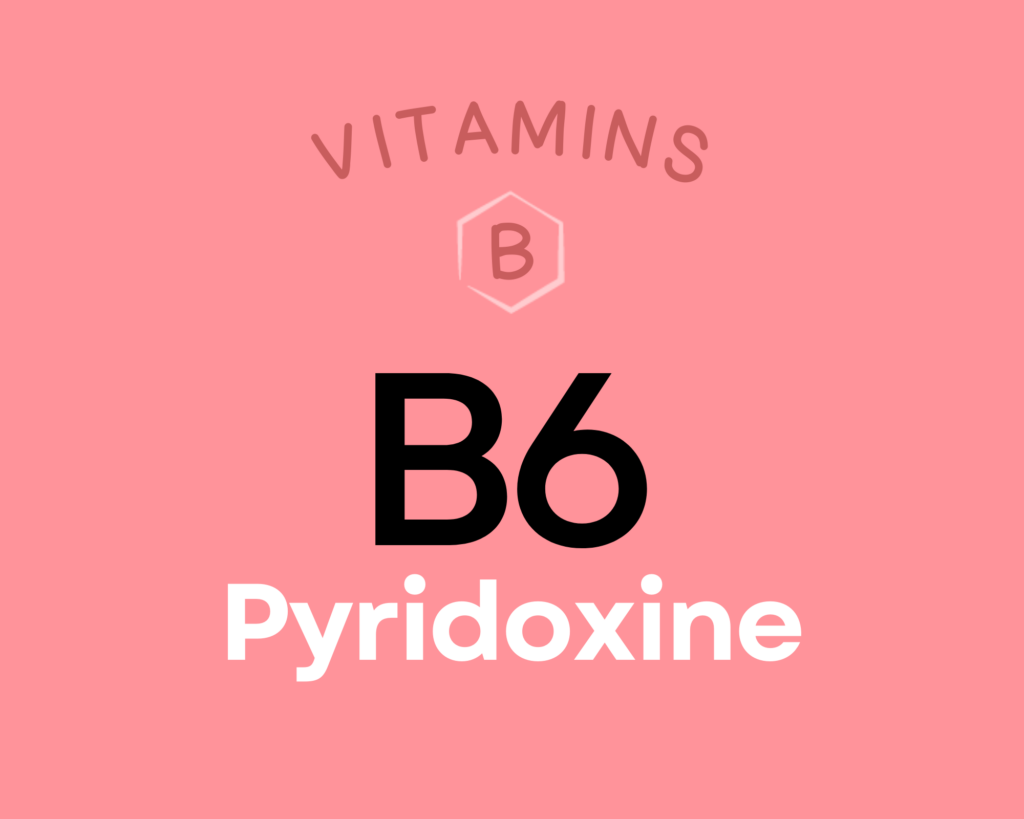
Vitamin B6 (pyridoxine) is a group of six water-soluble compounds with a similar chemical structure, all of which can be converted into their active form of pyridoxal 5’-phospate (PLP). Over 100 different enzymes require vitamin B6 in order to carry out their various functions in protein metabolism, fatty acid metabolism, neurotransmitter production, gluconeogenesis, hemoglobin synthesis, the release of glucose from glycogen, and energy metabolism (particularly the production of ATP in the Krebs cycle). Research suggests vitamin B6 may help protect against cardiovascular disease and certain cancers, could reduce the risk of depression among the elderly, and even reduce symptoms of morning sickness and PMS. Learn more about vitamin B6 here.
Learn What Foods Are the Best Sources of Every Nutrient

The Top 25 Foods for Every Nutrient
The Top 25 Foods for Every Nutrient e-book is a well-organized, easy-to-use, grocery store-friendly guide to help you choose foods that fit your needs of 43 important nutrients while creating a balanced nutrient-dense diet.
Get two “Top 25” food lists for each nutrient, plus you’ll find RDA charts for everyone, informative visuals, fun facts, serving sizes and the 58 foods that are Nutrient Super Stars!
Buy now for instant digital access.
How Much Ground Beef Should We Eat Per Day?
Red meat, such as ground beef, is a nutritionally valuable food and a great source of protein.
Proteins are the molecules that perform most of the various functions of life which is why protein deficiency is detrimental to all of the body’s organs and systems, including impacting function of the brain (especially in infants and young children), immune system, gut barrier, and kidneys. Dietary protein is necessary to supply the amino acid building blocks for all of the proteins in our bodies. Physical signs of protein deficiency include edema (swelling), poor musculature, dull skin, thin and fragile hair, and failure to thrive in infants and children.
The Accepted Macronutrient Distribution Ranges (AMDR) were established by the Food and Nutrition Board of the Institute of Medicine using evidence from interventional trials with support of epidemiological evidence that suggest a role in the prevention or increased risk of chronic diseases, and based on ensuring sufficient intake of essential nutrients. The AMDR for protein is 10% to 35% calories from protein.
The recommended daily allowance of protein is 0.36 grams per pound body weight (0.8 grams per kilogram of body weight). That amounts to 56 grams for a 150-pound person. However, it’s important to emphasize that this number is considered a minimum daily allotment, and there is no established upper limit. In fact, many studies have evaluated diets containing three to four times more protein than this minimum and proven benefits to weight management, body composition, hormone regulation, and cardiovascular health. These studies suggest that an optimal protein intake for most people is probably in the range of 1.2 to 1.8 grams per kilogram bodyweight (82 to 122 grams for that same 150-pound person), and that people who are very active may see the best results at even higher intake. Learn more about protein here.
Easily track your servings of Nutrivore Foundational Foods!

The Nutrivore Weekly Serving Matrix
The Nutrivore Weekly Serving Matrix digital resource is an easy-to-use and flexible weekly checklist designed to help you maximize nutrient-density and meet serving suggestions of Nutrivore foundational foods, all without having to weigh or measure your foods!
Includes a 22-page instructional guide and downloadable interactive guides.
Buy now for instant digital access.
cITATIONS
Expand to see all scientific references for this article.
Clements RS Jr, Darnell B. Myo-inositol content of common foods: development of a high-myo-inositol diet. Am J Clin Nutr. 1980 Sep;33(9):1954-67. doi: 10.1093/ajcn/33.9.1954. PMID: 7416064.
Ey J, Schömig E, Taubert D. Dietary sources and antioxidant effects of ergothioneine. J Agric Food Chem. 2007 Aug 8;55(16):6466-74. doi: 10.1021/jf071328f. Epub 2007 Jul 6. PMID: 17616140.
Froger N, Moutsimilli L, Cadetti L, Jammoul F, Wang QP, Fan Y, Gaucher D, Rosolen SG, Neveux N, Cynober L, Sahel JA, Picaud S. Taurine: the comeback of a neutraceutical in the prevention of retinal degenerations. Prog Retin Eye Res. 2014 Jul;41:44-63. doi: 10.1016/j.preteyeres.2014.03.001. Epub 2014 Apr 8. PMID: 24721186.
Kubo H, Fujii K, Kawabe T, Matsumoto S, Kishida H, Hosoe K. Food content of ubiquinol-10 and ubiquinone-10 in the Japanese diet. Journal of Food Composition and Analysis. 2008. Vol 21(3):199-210. https://doi.org/10.1016/j.jfca.2007.10.003.
Mushtaq S, Heather Mangiapane E, Hunter KA. Estimation of cis-9, trans-11 conjugated linoleic acid content in UK foods and assessment of dietary intake in a cohort of healthy adults. Br J Nutr. 2010 May;103(9):1366-74. doi: 10.1017/S000711450999328X. Epub 2009 Dec 8. PMID: 19968893.
USDA Food Central Database: Beef, ground, 85% lean meat / 15% fat, raw (Includes foods for USDA’s Food Distribution Program)
Watanabe T, Kioka M, Fukushima A, Morimoto M, Sawamura H. Biotin content table of select foods and biotin intake in Japanese. Int J Anal Bio-Sci. 2014. Vol 2(4):109-125.


